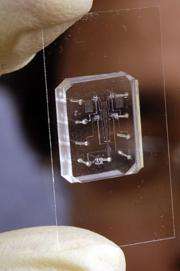Microfluidic chip helps solve cellular mating puzzle

Using a biochemical version of a computer chip, a team led by Johns Hopkins researchers has solved a long-standing mystery related to the mating habits of yeast cells.
The findings, described in the Feb. 18 Advance Online Publication of the journal Nature, shed new light on the way cells send and receive signals from one another and from the environment through a process called signal transduction. That process, when impaired, can lead to cancer or other illnesses.
"Yeast is a very simple single-celled organism, but in many respects it operates much like a human cell," said Andre Levchenko, an assistant professor in the Department of Biomedical Engineering at Johns Hopkins and supervisor of the research team. "That’s why it’s been studied for many years -- because what we find out in yeast often holds true for humans as well. In this study, we looked at how yeast cells signal one another when they want to merge, engaging in a type of mating behavior. Human cells ‘talk’ to one another in a similar way, and it’s important to understand this process."
Yeast cells mate by sending out pheromone designed to catch the attention of nearby cells of the opposite mating type. When a prospective partner picks up this "scent," it alters its shape and sends a projection toward the source of the pheromone, leading to a cellular merger. This mating process is regulated by proteins inside the cell called mitogen-activated protein kinases, or MAPKs, through a chain of chemical reactions.
First, sensors on the surface of a yeast cell pick up signals that a mating partner is nearby. Then the message is passed down toward the cell’s control center, the nucleus. The messengers that carry it to the nucleus are MAPKs, which direct the cell’s response by triggering multiple genes. But biologists have been baffled for years as to why two different forms of MAPKs perk up when the mating call arrives. Only one of them, called Fus3, appeared to be in charge of the courtship process, while the other was thought to be moonlighting away from its main job in another signaling pathway.
"The role of the second type of MAPK was unclear," said Saurabh Paliwal, a doctoral student in Levchenko’s lab and lead author of the Nature article. "Through experiments with a microfluidic chip and with mathematical modeling, we were able to learn that this second MAPK, called Kss1, does play a crucial role. Without it, the mating process does not proceed as smoothly."
The microfluidic chip was invented and patented by a team that included Levchenko and Paliwal, who teamed up with Alex Groisman, a physicist from the University of California, San Diego. In place of the microscopic electrical circuitry of a computer chip, their device consists of a series of tiny channels and chambers, some 20 times smaller than the diameter of human hair. Within the chip, computer-controlled fluid pressure and microscopic valves allow the researchers to isolate and conduct experiments on extremely small clusters of cells. "The level of control we can achieve on the conditions affecting just a few cells is unbelievable," Levchenko said. "This is far beyond what you can do in a traditional biology lab dish that’s filled with a large colony of cells."
Using cameras attached to a microscope, the researchers were able to view a microfluidic chip and study the mating behavior of yeast cells in response to different concentrations of pheromone in the presence or absence of Kss1. They were surprised to find that this second MAPK, thought to be relatively unimportant, actually helped the yeast cells do a better job of finding a mate through two distinct functions. First, it helped cells diversify their responses at low pheromone concentrations, so that only a small fraction of cells might engage in "expensive" mating behavior, which consumes a lot of cellular resources. Second, in the cells that were attempting to mate, Kss1 improved the precision of finding the partner.
The researchers said their findings show the importance of unraveling the role of multiple, apparently redundant proteins that are often activated by the same message passing through a cell. They also address why cells do not get confused when they are activated by multiple signaling messengers. Such findings may help produce medications with fewer side effects and others that target mutations associated with cancer.
Source: Johns Hopkins University















